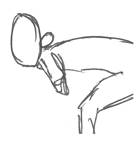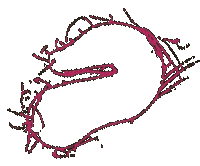May 18, 2006
Balls, Appreciation
Balls, Appreciation
I want to funnel spherical objects using only gravity. These objects need to travel from a hopper, through a tube, single file and out the other end. This should be done with a reliable and consistent flow.
The objects I have are consumer versions of your everyday ball-pit balls that you might find in a fast food playground. The balls are made from a thin, blow-molded vinyl. The spheres hold air, with a bit of pressure, that returns the shape of the ball after being pressed but not so much that the ball would deflate and change shape if a hole were poked in it. The diameter of these balls measure at least an inch smaller at 2.5" than the standard ball size and are priced accordingly in multicolored packs of 100.
Funneling solid objects presents some interesting problems as I'll describe through my trials and experiments. The key thing to know is that you have to deal with a fundamental particle size. In the case of sand that size could be well under half a millimeter while in my project it's the 2.5" of the ball diameter. I realize that these experiments will not necessarily apply to other particle shapes but they should translate to other scales. Working in the realm of geometry, it becomes a luxury to be dealing with these near perfect spheres. They act the same way in any orientation to gravity and to their fellow spheres.
Trail 1(foray in funneling)
(fig1)

I want to make things easy on my self and use just gravity to funnel the balls. I'd like to avoid moving parts to save on time and effort. Out of cardboard I constructed a hopper made of four flat, trapezoidal planes in the shape of a square-bottomed pyramid with it's top truncated. The long side of the trapezoid measures 25", the short side runs 4" and the trapezoid height comes in at 19.5"(fig1).
I left enough room in the 4" opening for the balls to get through and still be able to run into my 3" diameter tube through a coupling adaptor. That was the idea. I set the funnel on stand for it's first test and dumped all 100 balls in. The first few flowed out nice but soon there after, the group of balls got hung up. They tended to wedge themselves in the funnel so that none could get out. I was able to stick my hand up the chute to dislodge them but promptly they would repeat that which I had just undone. Being the technical whiz I am, my next idea consisted of whacking the funnel on the side to make it work. This and more steady vibration had similar effects as the "hand up the chute" method.
(fig2)

After this, I decided to investigate the nature of the lodging. I did a little excavating of the funnel and found at the bottom four balls holding up the party and a set of nine balls in the same manner just above them (fig2). They would prop themselves up against the side and each other. Sort of like all three stooges trying to get through the door at the same time, I've got to figure out how to make them go one by one.
Roundabout Snatch
When I get the question "Teach me a trick" this is one I pull out. It's quick to learn, looks harder than it is and falls well within most people abilities. Most able-bodied adults and children have a successful attempt in their first five tries. The idea is to hold a ball, or small object in the hand, drop that ball, move your hand in a full circle around the falling ball and snatch it out of the air before it hits the ground.

Procedure:
Hold the ball in your hand with your palm facing down. I should pause here. It's a bit deceptive to say "drop the ball" at this point. The drop is not really a drop. You, very slightly, lift the ball as you drop it. This gives some extra time for the move. The easiest move to start with is a circle from inside to out. With the right hand this is a counterclockwise circle and clockwise for the left. After releasing the ball, you drop your hand to the inside, then moving to the outside under the ball. As the ball falls your hand completes the circle and you snatch the ball from the top.
At this point you should be holding the ball the same way you started with. While learning, it is a good idea to keep your body loose as you practice. Bend at the waist a little and flex your knees. It's much easier for your body to follow the ball down in this stance, should you need the extra time.
Variations:
1. Learn to perform both clockwise and counterclockwise circles in each direction.
2. Performing this trick in the left and right hand, in sync, impresses many people.
3. Try for double or triples. Start high and take advantage of the full length of the fall to the ground by doing multiple circles before the snatch
Trial 2 (nine-ball float)
(fig3)

After looking at the structure of the four ball and nine-ball lodgings, it appeared that a key to solving this problem was the floating ball in the center of the nine-ball layout. That ball was not directly subject to the wedging action of the sides of the funnel. I theorized that if I built a platform in the bottom of the funnel just big enough for a nine-ball structure to lay on with a bit of wiggle room, that I could simply cut a ball sized hole in the middle of that platform for the floating ball to flow through. Other balls would come behind it to fill the empty space. That platform needed to be 6.5" square to hold the balls at the right height (fig3).
Just as before, the balls were dumped in to the funnel. The results proved to be much worse. What was I thinking? Sure, just make a smaller opening at the exact right place and the balls will just come flowing out... Several problems presented. First the balls wouldn't always bottom out perfectly into the nine-ball lay. The act of dumping the balls in the funnel is so chaotic that reliably getting that perfect result is out of the question nearly every time. Second, the eight balls that I had expected to stay stationary, to allow the floating ball to fall through, acted very similarly to the walls of the funnel. They created their own mini one ball funnel in the funnel only to become clogged the same way the outer version did.
Elbow Bounce
This trick is something that you've seen a million times. Every father from here to Sheboygan has pulled this one out to impress the kids. It's proven through time as a trick that's easy to learn but hard to master in its subtleties. The trick goes like this: hold a ball while the arm bends at the elbow, then drop the ball while straitening out the arm to hit the ball into the air.

Procedure:
The smaller the person, the lighter a ball I recommend for this. Less force is necessary in the arm straightening to hit a lighter ball hard enough for the trick. Start with a medium weight and adjust as to what feels right for you.
Hold the ball in your hand with your palm facing you. Bend your arm at the elbow towards you, like you are showing off your arm muscles. Don't hold your arm straight out. Lower your upper arm to about 45 degrees in relation to your shoulders. Allow your wrist to droop and hang your hand above the elbow. From this position drop the ball and pop your elbow straight in one motion. As the ball jumps up in the air catch it with the same hand.
It's important to lower your arm out of alignment with your shoulders. Straightening out the elbow from this lowered position gains the most vertical motion from the point of contact with the ball. At first, be careful not to throw your arm out too fast as it can cause some injury to the arm if repeated too often.
Variations:
1. The ball trajectory can be aimed with just little finesse. Hit right on the elbow to throw straight up. Hit on the upper arm to throw away from your body and on the forearm to throw towards.
2. The ball can indefinitely bounce on the elbow with short pops right on the elbow without a catch.
3. By turning the arm a little, the ball can be bounced between your two elbows with no hands involved
4. Reverse the action of the elbow bounce to create an elbow catch by means of holding the ball between the upper and lower arm in the elbow.
Trail 3 (give up but don't go all the way)
(fig4)

This is where I partially give up on the "gravity only" thing. It left the platform in place but this time I cut out the center third. I knew that wouldn't be enough. We all could have seen that coming. The significant design change was the addition of a paddle wheel acting on about half of that opening (fig4). This introduced a very simple mechanic. The paddle wheel was situated half way in the funnel with a cutout on the side for it to rotate through. The size of the paddles and the cut outs prevented balls form escaping through the side hole.
The paddle wheel functioned as an agitator on the lower part of the group of balls. I experimented with reversing the rotations as well. The results were, again, disappointing. The same type of blockages set themselves up in the funnel. This time, the blockages left just enough room for the paddle wheel to scrape by to no effect. In the attempts that did dislodge balls, they would often get stuck between the paddle wheel and the platform or wall depending on the direction of rotation.
An issue not noticed before was the effects of dampening in this system. A paddle wheel acting on a small set of balls in the funnel had a greater effectiveness in funneling. With the smaller group, the balls had room to move and bounce around. The motion of the wheel was significant enough to move the entire grouping. With the whole test set of 100 balls in the funnel, the upper balls severely dampen the movement of the lower balls. After an initial period of stabilization, the chaotic effect on the system became close to zero. When the paddles could act on the balls, the reaction of the balls was consistent and repeatable due to the dampening. A set of balls would be pushed up as a group kept inline by the rest of the set staying in there relative positions within a grid. This grid seemed to be a function of the size of the balls and the shape of the funnel.
Neck Catch and Return
The Catch
The neck catch makes a great stall, or pause in the middle of a juggling routine. It can also be used singularly as a party trick or a finale to any ball manipulation. Let's talk about how to accomplish this.

Procedure:
It's best to learn this trick with a ball that has a good amount of give in it. Beanbags or hacky sacks show more forgiveness, as they will resist bouncing off your neck when they land. We'll talk about other considerations for more advanced methods later.
The trick starts with a throw straight up in front of you. This throw should travel in a line about a foot in front of you. A throw straight over your head does not leave any room for the changing position of the neck when you bend over to catch it. You should start with a throw height about two to three feet above your head. The catch can conceivably be completed with a well aimed a throw of any height but it's good to start with the easy control of a short throw.
As you throw, keep your eyes on the ball. Look at the ball until the very last second when the ball is about to hit you. At that moment flick your head down to catch the ball. There are two essentials for a successful catch. First, keep your head facing forward. This creates one side of the pocket that the ball falls into. Second, lift your shoulder blades by throwing your arms out to your sides to create two more sides to the pocket.
The Return
After you get the catch down, you can learn the return. The return is a bit more advanced but is invaluable as a visual counterpoint to the catch. In this, from the neck catch position, the ball rolls down the head and is tossed up and back into your hand or juggling pattern.
Procedure:
This part assumes that you already have a grasp on the catch technique. With this you need to be able to catch and control a ball that holds it's shape better. A stiffer ball makes for an easier roll off the head.
With the ball on your neck, slowly tilt your head down allowing the ball to roll down the center of your head. Just as it reaches the crest on the back of your head, stand up straight and lift up your head. This should flick the ball up into the air just high enough for a simple hand catch. It's important to note that as you lift your upper body and head, you should perform this in one smooth motion, as consecutive events. The back must roll up like a piece of ribbon with the head lagging behind until just the last moment when it whips up to propel the ball. Make sure that the ball stays exactly centered on the head as it rolls up. This takes a lot of practice; otherwise the ball flies off in unpredictable directions.
Variations:
1.From the neck, the ball can be allowed to roll down the back and caught by a well-placed hand between the legs.
2.With practice, the ball's return can be directed straight up to again be caught on the neck.
3.From the neck, the ball can be rolled up the head. With a deft touch, the ball can come to rest balanced on the forehead, having never lost contact with the surface.
Conclusion (what works, what might work, where to look for a solution)
I'd like to say this right at the start, I believe there is no way of gravity only funneling given the conditions that I use; a hopper/funnel to hold the whole set of balls and traveling into a tube single file. There are, however, two things that could be changed to make this work. The first is the addition of mechanics and external movement. I'll discuss this a little later. The second is the expansion of the size of the tube.
I did a little more experimenting. I don't have any hard numbers to back these thoughts up, but when you expand the hole or tube so that nine balls can fit through at the same time, funneling becomes much more reliable. I expect that this comes from the probability for formation of a lodging. If we allow all the eight ball squares (nine-ball pattern minus the floating center ball) to fall through by making a large enough hole, we are left with only 12 ball squares that can act as the basis for a lodging (fig 5). My intuition tells me that these would occur much more rarely, even exponentially so, when compared to four and eight ball squares.
(fig5)

The funnel as it started out, worked better the lower the number of balls in the funnel at a time. With one ball at a time, the system works beautifully. Increasing the number to two, the chances of a lodging increase and so on for larger numbers. The chances of a full, successful funnel of the entire set of 100 is possible but exceedingly small.
At this point you can start looking for alternative answers that get the job done by leaving behind the conditions of the original problem. The simplest of these other solutions is to skip the hopper and funnel in favor of a long preloaded tube. This eliminates the need for any funnel since the ball start in single file.
Another is to take a cue off of a gumball machine. The rotating base allows enough time and agitation for a ball to settle down into place between blades before it drops into the chamber for you to retrieve it from.
Aside (let's drop this funnel)
As an aside, this shape, that the funnel is, makes an excellent object for dropping through air. You can play with it in a manner similar to how you might play with a plastic parachute man. The properties are such that it tends point down in flight. The large end creates enough drag to turn it down. The shape also creates low pressure in the interior of the shape as it wedges though the air. The low pressure, combined with the drag, makes the shape fall slower than you would expect. And finally, the best part: even with the mere 4" measurement of the base, the shape likes to land perfectly on it's end without falling over. Amazing.
I hope this helps


